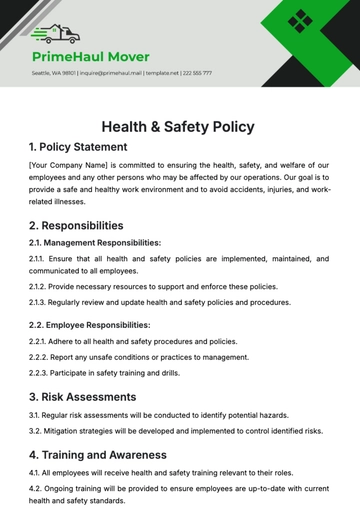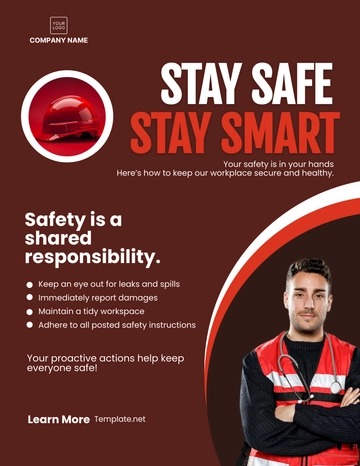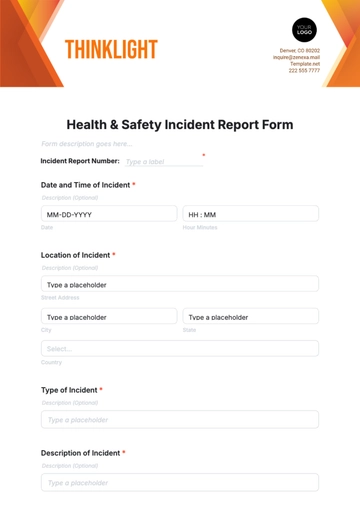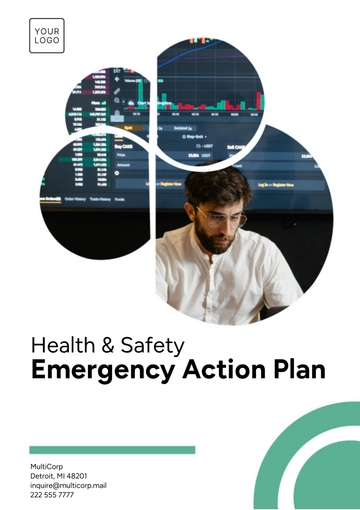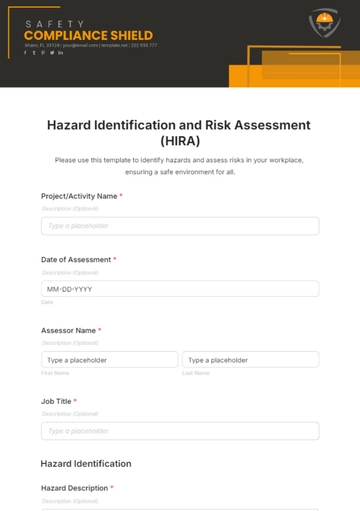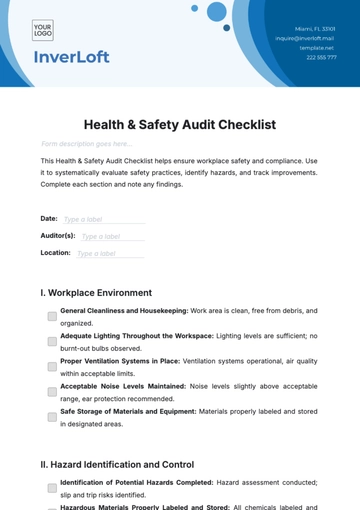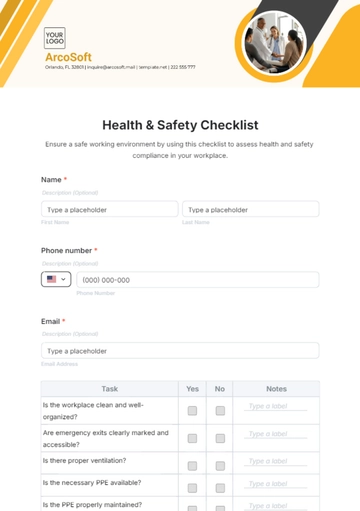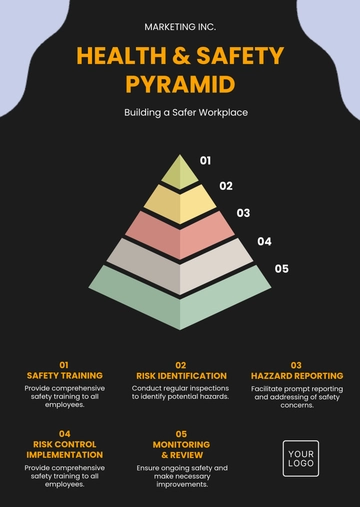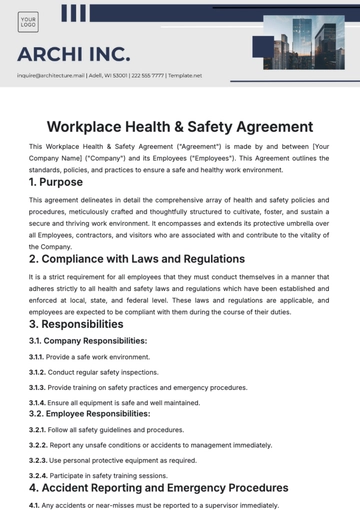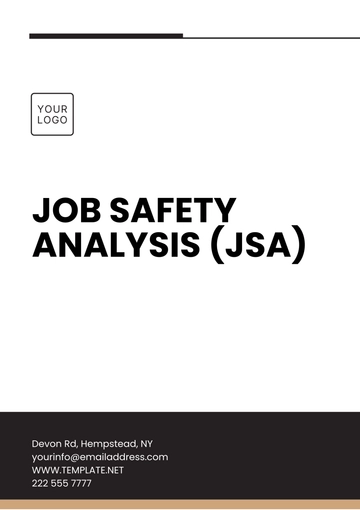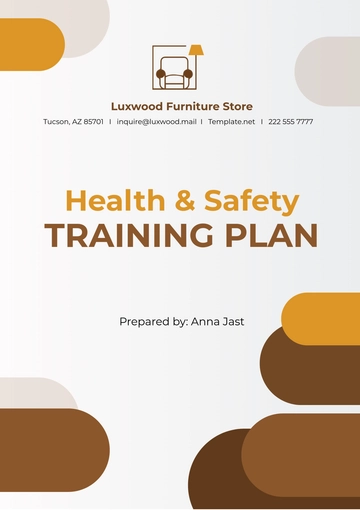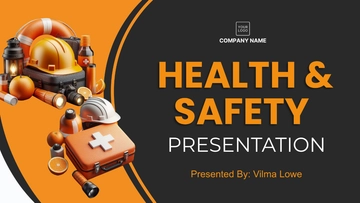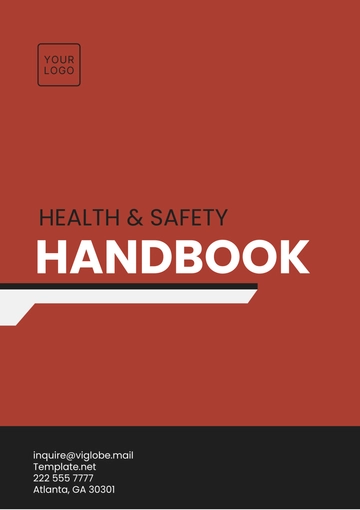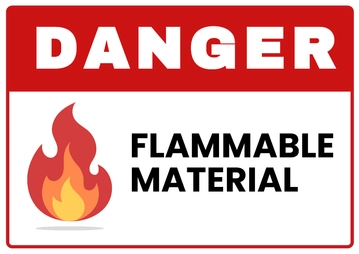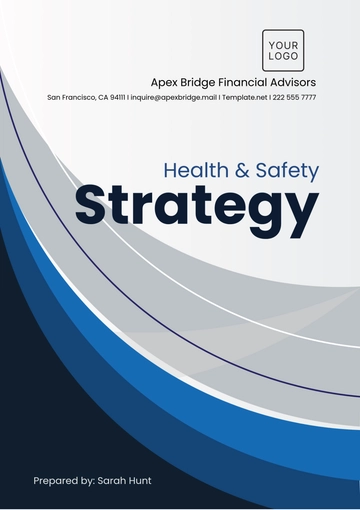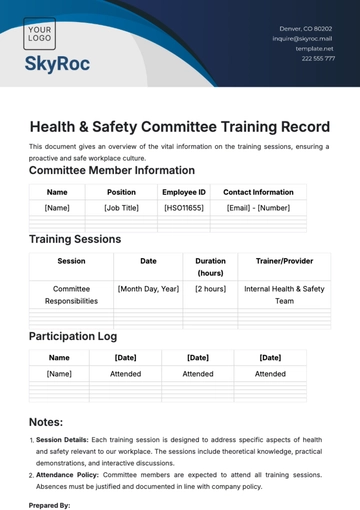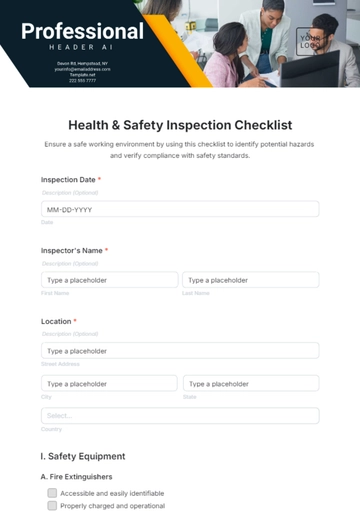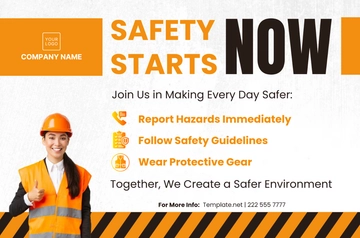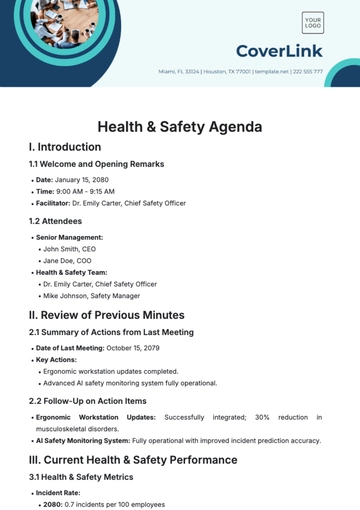Free Health & Safety Committee Management Journal
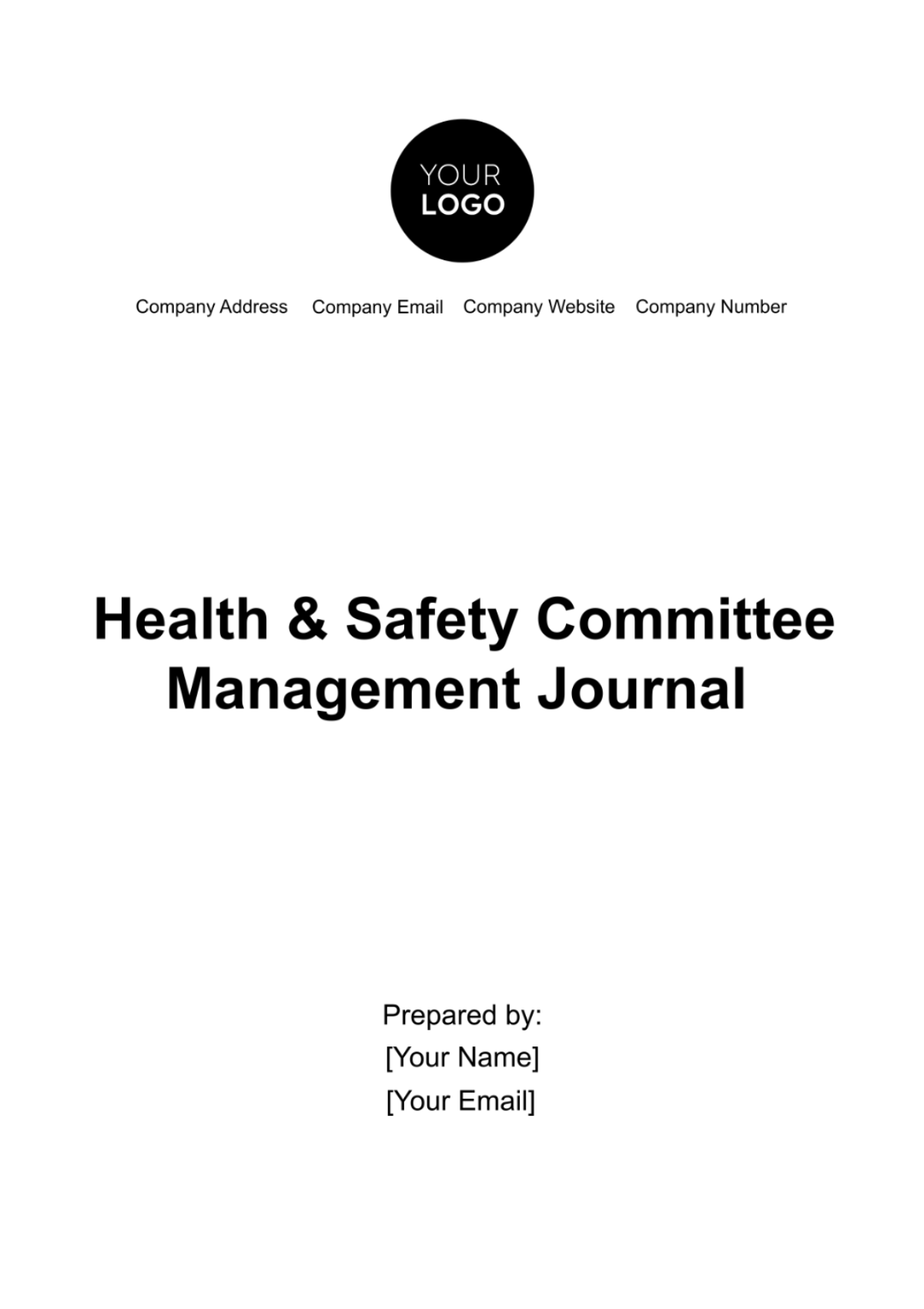
Management Journal
1. Introduction
1.1 Overview of Health & Safety Importance
In the contemporary workplace, the importance of health and safety cannot be overstated. It is not only a legal requirement but also a crucial aspect of ensuring a productive and positive work environment. A well-implemented health and safety program can significantly reduce accidents and illnesses, leading to lower absenteeism, increased morale, and enhanced productivity. Our commitment to health and safety is reflected in our proactive approach to identifying risks, educating employees, and continuously improving our safety practices.
1.2 Purpose of the Committee
The Health & Safety Committee is established with the primary objective of overseeing and improving all aspects of workplace health and safety. This committee serves as a platform for discussing safety concerns, developing safety protocols, and ensuring compliance with regulatory standards. The committee's role extends beyond mere compliance; it aims to foster a culture where safety is ingrained in every action and decision within the organization.
2. Formation of the Committee
2.1 Criteria for Member Selection
To ensure a comprehensive approach to health and safety, our committee members are selected based on a diverse set of criteria. These include expertise in safety protocols, experience in handling emergency situations, and a background in employee training and welfare. We prioritize a mix of roles from various departments to ensure a holistic perspective. Candidates are required to have at least two years of experience in their respective fields and must demonstrate a clear understanding of health and safety regulations.
2.2 Table of Committee Members
The following table lists the inaugural members of our Health & Safety Committee, outlining their roles and qualifications.
Member Name | Department | Role in Committee | Qualifications |
[Your Name] | Operations | Chairperson | 10 years in operational management, certified in OSHA standards. |
[Name] | Human Resources | Vice-Chairperson | HR manager with a focus on employee wellness programs |
[Name] | Facility Management | Safety Officer | Expertise in building safety, fire safety certified |
[Name] | Production | Member | Experience in production safety, ergonomic assessment qualified. |
[Name] | Warehouse | Member | Knowledge in warehouse safety, forklift operation certified |
3. Committee Roles and Responsibilities
3.1 Description of Roles
Chairperson (John Doe): Responsible for leading the committee, setting agendas, and liaising with senior management. John brings a decade of experience in operational management and is well-versed in OSHA standards.
Vice-Chairperson (Jane Smith): Assists the Chairperson and leads in their absence. Jane focuses on employee wellness programs, making her a valuable asset for promoting a safety culture.
Safety Officer (Alex Johnson): Alex specializes in facility safety and is tasked with regular safety audits and emergency response planning.
Committee Members (Emily Turner, Michael Rodriguez): Both Emily and Michael contribute their expertise from production and warehouse perspectives, ensuring that safety considerations are comprehensive and department specific.
3.2 Responsibility Matrix
This table assigns specific responsibilities to each committee role, ensuring clear accountability and task distribution.
Role | Responsibilities |
Chairperson | Overseeing committee operations, reporting to management |
Vice-Chairperson | Supporting the Chairperson, leading employee engagement |
Safety Officer | Conducting safety audits, emergency planning |
Committee Members | Providing department-specific insights, supporting initiatives |
4. Health & Safety Policies and Procedures
4.1 Existing Policies Review
Our current health and safety policies encompass a range of areas including emergency response, equipment handling, and workplace ergonomics. The committee has conducted a thorough review of these existing policies to identify areas for improvement. Key findings suggest a need for enhanced fire safety measures and updated protocols for handling hazardous materials. The policies have been effective in maintaining a low incident rate but require periodic updates to align with new safety standards and technological advancements.
4.2 Procedure for Policy Development
The development of new health and safety policies follows a structured process:
Identification of Needs: The committee assesses current workplace safety needs based on recent incident reports, employee feedback, and safety audits.
Drafting: Based on identified needs, draft policies are created, focusing on areas like training requirements, equipment usage, and incident response.
Review and Feedback: Draft policies are circulated among key stakeholders for review and feedback. This includes department heads, legal advisors, and selected employee representatives.
Finalization and Approval: Incorporating feedback, the final policies are drawn up and submitted to management for approval.
Implementation: Approved policies are communicated to all employees and integrated into the company’s safety training programs.
5. Risk Assessment and Management
5.1 Risk Identification Methods
Our approach to risk identification is multifaceted, involving regular workplace inspections, employee surveys, and analysis of incident reports. We also utilize technology, such as safety monitoring systems, to identify potential hazards. This proactive approach helps in early identification of risks, allowing for timely interventions.
5.2 Risk Assessment Table
Below is a table summarizing key risks identified in our workplace, along with their potential impacts and proposed mitigation strategies.
Risk Category | Identified Risk | Potential Impact | Mitigation Strategy |
Fire Safety | Inadequate fire exits | High risk in emergency | Install additional fire exits, conduct regular fire drills. |
Chemical Handling | Exposure to hazardous substances | Health hazards to employees | Provide PPE, implement strict handling protocols. |
Equipment Safety | Malfunctioning machinery | Injury risk | Regular maintenance checks, operator training |
Ergonomics | Poor workstation design | Musculoskeletal disorders | Redesign workstations, provide ergonomic training. |
6. Training and Awareness Programs
6.1 Training Requirements
Our committee strongly believes in the power of training to foster a culture of safety. To this end, we have developed a comprehensive training program that covers various aspects of health and safety. Mandatory training sessions include fire safety, emergency response, ergonomic practices, and proper handling of hazardous materials. These trainings are designed to be interactive and engaging, ensuring that employees not only learn but also apply these practices in their daily work.
6.2 Training Schedule Table
The following table outlines the schedule for upcoming training sessions, including the topics covered and the designated trainers.
Date | Training Topic | Trainer | Target Audience | Duration |
Jan 20, 2051 | Fire Safety Awareness | [Your Name] | All Employees | 2 Hours |
Feb 10, 2051 | Emergency Response | [Your Name] | Floor Managers | 3 Hours |
Mar 05, 2051 | Ergonomics at Work | [Your Name] | Office Staff | 1 Hour |
Apr 15, 2051 | Handling Hazardous Materials | [Your Name] | Warehouse Staff | 2 Hours |
7. Incident Reporting and Investigation
7.1 Incident Reporting Procedures
Our incident reporting procedure is designed to be straightforward and accessible to encourage prompt reporting of any safety concerns or incidents. Employees are instructed to report any incidents immediately to their supervisor or directly to a safety officer. The report must include details of the incident, such as the time, location, and any witnesses. This information is critical for a timely and effective investigation.
7.2 Incident Log Table
The table below provides a record of recent incidents, documenting their nature and the follow-up actions taken. This log is crucial for tracking patterns and improving safety measures.
Date | Incident Description | Reported By | Follow-Up Action Taken |
Nov 12, 2050 | Chemical spill in Warehouse Area B | [Your Name] | Spill contained; staff retrained on procedures. |
Dec 08, 2050 | Minor fire in Break Room Kitchen | [Your Name] | Fire extinguished; kitchen safety reviewed. |
Jan 15, 2051 | Slip and fall in Office Lobby | [Your Name] | Area inspected; anti-slip mats installed. |
Feb 20, 2051 | Equipment malfunction in Production | [Your Name] | Equipment repaired; safety checks increased. |
8. Conclusion
8.1 Summary of Committee Achievements
Since its inception, the Health & Safety Committee has made significant strides in enhancing workplace safety. Key achievements include the successful implementation of a comprehensive risk assessment program, development of new safety protocols in response to identified hazards, and an overall reduction in workplace incidents by 30%. The committee's efforts in organizing extensive employee training sessions have been particularly effective, resulting in heightened safety awareness among staff.
8.2 Future Goals
Looking ahead, the committee aims to further reduce incident rates by introducing advanced safety monitoring technologies and expanding our mental health and well-being programs. We plan to establish stronger engagement with all employees through regular safety workshops and feedback sessions. Another major goal is to achieve recognition for our safety standards through industry certifications, setting a benchmark for safety excellence within our sector.
- 100% Customizable, free editor
- Access 1 Million+ Templates, photo’s & graphics
- Download or share as a template
- Click and replace photos, graphics, text, backgrounds
- Resize, crop, AI write & more
- Access advanced editor
Facilitate your committee's activities with Template.net's Health & Safety Committee Management Journal Template. Editable and customizable, this journal offers a systematic approach to record and manage health and safety efforts. Ideal for committee leaders, it helps track progress, document meetings, and outline action items, ensuring effective oversight of safety initiatives.

